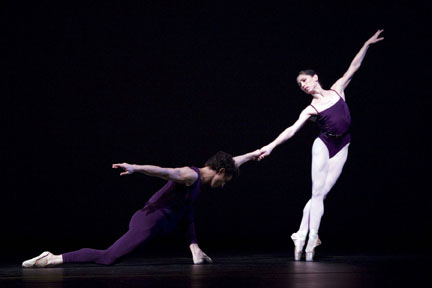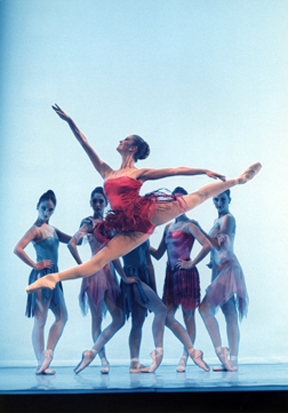New, Old and New Again
“Castle Nowhere”
Royal Ballet
Royal Opera House, Covent Garden, London
March 28 – April 12
“How I Look”, “Tiger Dancing”, “Expression Lines”
Henri Oguike Dance Company
Richmond Theatre, Surrey
March 27, and touring until May 25
“Pas de Quatre”, “Variations for Four”, “Perpetuum Mobile”, “Who Cares?”
English National Ballet
Richmond Theatre, Surrey
March 30 to April 1
by John Percival
copyright 2006 by John Percival
 There’s a widespread belief that companies must do new work for the sake of their dancers and their audiences. I’m not fully convinced. Take the Royal Ballet, for instance. They’ve just announced their plans for next season, 2006-7, and there are to be four creations. How many people who want classical ballets by RB-trained, NY-based Christopher Wheeldon and by company member Alastair Marriott will look forward equally to work by modernist Wayne McGregor, or vice versa? And do we need a new “Seven Deadly Sins” by Will Tuckett? Whereas there are only two Ashton ballets all season: “Rhapsody” and “Symphonic Variations” —respectively three and six performances! The biggest single improvement in dance standards at Covent Garden lately came in the season when the company was stimulated with lots of Ashton revivals; and audiences too enjoy heritage works or other revivals (which will be new to many of them anyway).
There’s a widespread belief that companies must do new work for the sake of their dancers and their audiences. I’m not fully convinced. Take the Royal Ballet, for instance. They’ve just announced their plans for next season, 2006-7, and there are to be four creations. How many people who want classical ballets by RB-trained, NY-based Christopher Wheeldon and by company member Alastair Marriott will look forward equally to work by modernist Wayne McGregor, or vice versa? And do we need a new “Seven Deadly Sins” by Will Tuckett? Whereas there are only two Ashton ballets all season: “Rhapsody” and “Symphonic Variations” —respectively three and six performances! The biggest single improvement in dance standards at Covent Garden lately came in the season when the company was stimulated with lots of Ashton revivals; and audiences too enjoy heritage works or other revivals (which will be new to many of them anyway).
We just had another of this year’s new productions, “Castle Nowhere” by the 30-year-old Canadian choreographer Matjash Mrozewski. Memories of a piece he made in 2004 for a short-run RB studio programme commemorating Diaghilev made me look forward to his further creation, but it disappointed. The subject isn’t made very clear but seems to concern a couple (Zenaida Yanowsky, Edward Watson) who try to avoid the attraction that draws them together. Three other couples complicate the situation; all of them have problems, I feel. The dancers move around without making strong patterns or drama. Yannik Larivée’s setting comprises household objects hung above the stage; Caroline O’Brien costumes the women in dresses with bustles and the men in black suits (these designers are also Canadian and have worked with Mrozewski before). The music is a symphony by Arvo Part. Nothing really hangs together. It isn’t boring, but isn’t something to live with either; unfortunately most critics and many spectators vehemently disliked it.
 PHOTO Chris Nash.jpg) For me, a new programme by Henri Oguike’s modern-dance company was more enjoyable. He has a gift for making his dancers look lively and exciting. Their latest group number, “How I Look”, has eleven of them (including two excellent apprentices) dressed in colourful gear, making a high-spirited comic exploration of the stage, while competing with varied light effects and interrupted by whistles. Danced to a jolly little concerto by Vivaldi, the movement is full of funny walks and twisting heads, and you might be surprised how well these go together. I guess Oguike chooses his dancers for personality, but that doesn’t imply any lack of physical skill, and the combination is terrific.
For me, a new programme by Henri Oguike’s modern-dance company was more enjoyable. He has a gift for making his dancers look lively and exciting. Their latest group number, “How I Look”, has eleven of them (including two excellent apprentices) dressed in colourful gear, making a high-spirited comic exploration of the stage, while competing with varied light effects and interrupted by whistles. Danced to a jolly little concerto by Vivaldi, the movement is full of funny walks and twisting heads, and you might be surprised how well these go together. I guess Oguike chooses his dancers for personality, but that doesn’t imply any lack of physical skill, and the combination is terrific.
Another recent production, “Tiger Dancing”, again looked experimental in the movement of its duets and solos, but I really couldn’t see how either the dances or Steve Martland’s specially written score were supposed to relate to the ostensible inspiration, William Blake’s celebrated poem “Tyger, tiger, burning bright…”. More like stick insects, suggested my companion. And Oguike’s own solo on this programme, “Expression Lines”, danced to blues music from Mali, doesn’t quite meet his usual standard. I do wish, too, that his lighting collaborator Guy Hoare wasn’t quite so keen here, and all evening, on dark stages. However, a revival of last year’s creation, “Second Signal”, came up even better than before: thrilling sound of traditional Japanese drums from the (British) group Taiko Meantime, and thrilling performances by the dancers. A show beginning with that and ending with “How I Look” reaches a standard most British choreographers can only envy.
 Oguike was one presentation in the annual “Leap into dance” week at Richmond Theatre in London’s south suburbs; another was a small-scale programme by English National Ballet, and it was this that set me thinking about new works. Their evening of exuberant dancing in varied moods contained four ballets, the most recent of them already nine years old; they made up an enjoyable show with no weak links. The centrepiece consisted of two showpiece quartets by the company’s long-ago founder, Anton Dolin, revived and adapted by his heir, Jelko Yuresha. The famous “Pas de Quatre”, you’ll remember, evokes the ballerinas of 1845 who were originally brought together in it: Cerrito, Grahn, Grisi and Marie Taglioni. Dolin’s version of it, using the original Pugni score, was made for American Ballet Theatre in 1941and mounted for ENB (at that time called Festival Ballet) in its earliest days, but hasn’t been given recently. This revival cast can’t match the days when Alicia Markova used to lead three other international ballerinas, but Elena Glurdjidze is pretty stylish as Taglioni, and three soloists do decently enough in support. Dolin made “Variations for Four” in 1957 as a companion piece and to show off the virtuosity of his then leading men. Yuresha has inflicted some ghastly new costumes covered in spangles on today’s cast, but these men (a soloist and three principals) are tough enough to get away with it. Yat-Sen Chang’s leaps are particularly impressive, and Dmitri Gruzdyev does even better by the flair with which he carries off the extremely elegant and romantic solos that were created for the uniquely gifted John Gilpin.
Oguike was one presentation in the annual “Leap into dance” week at Richmond Theatre in London’s south suburbs; another was a small-scale programme by English National Ballet, and it was this that set me thinking about new works. Their evening of exuberant dancing in varied moods contained four ballets, the most recent of them already nine years old; they made up an enjoyable show with no weak links. The centrepiece consisted of two showpiece quartets by the company’s long-ago founder, Anton Dolin, revived and adapted by his heir, Jelko Yuresha. The famous “Pas de Quatre”, you’ll remember, evokes the ballerinas of 1845 who were originally brought together in it: Cerrito, Grahn, Grisi and Marie Taglioni. Dolin’s version of it, using the original Pugni score, was made for American Ballet Theatre in 1941and mounted for ENB (at that time called Festival Ballet) in its earliest days, but hasn’t been given recently. This revival cast can’t match the days when Alicia Markova used to lead three other international ballerinas, but Elena Glurdjidze is pretty stylish as Taglioni, and three soloists do decently enough in support. Dolin made “Variations for Four” in 1957 as a companion piece and to show off the virtuosity of his then leading men. Yuresha has inflicted some ghastly new costumes covered in spangles on today’s cast, but these men (a soloist and three principals) are tough enough to get away with it. Yat-Sen Chang’s leaps are particularly impressive, and Dmitri Gruzdyev does even better by the flair with which he carries off the extremely elegant and romantic solos that were created for the uniquely gifted John Gilpin.
I’m sure that Dolin would have been proud of Christopher Hampson, a former ENB dancer who today is arguably Britain’s best classical choreographer. His earliest ballet, from 1997, was revived to open this bill. Called “Perpetuum Mobile”, it uses Bach’s Violin Concerto in E major as the basis of an exceptionally lively suite of dances for five women and four men, led with great panache by Sarah McIlroy and Daria Klimentová.
Completing the programme was Balanchine’s “Who Cares?” I think this work must have been as much fun for its choreographer to make as it is for us to watch, since he took music by Gershwin for a ballet about his beloved Broadway. ENB first danced it in 1996 and have generally looked lively in it. I was especially impressed this time by how the immensely gifted Dmitri Gruzdyev went straight from his part in “Variations for Four” to head this ballet also, partnering all three leading women (Erina Takahashi, Sarah McIlroy, Simone Clarke) in their demanding and distinctive numbers and still having energy to be able to tackle his own long solo with a broad smile. He has actually done this role before, but most dancers all evening will have been tackling new parts, so you certainly do not need specially created ballets to stimulate the performers. And the audience was clearly having a great time too—as indeed was I, in spite of previous familiarity with all these works. I leave the thought with you.
Photos:
First: Leanne Benjamin and Martin Harvey in Christopher Wheeldon's "Polyphonia." Photo: Johan Persson.
Second: Dancers of Henri Oguike's company.
Third: Dancers from English National Ballet in "Who Cares?" Photo: Bill Cooper.
Volume 4, No. 13
April 3, 2006
copyright ©2006 John Percival
www.danceviewtimes.com